Research Article - (2023) Volume 12, Issue 4
The present work is focused on functionalizing Montmorillonite (Mt) with Poly Dimethyl Siloxane (PDMS) to develop a hybrid membrane reactor for the removal of Co (II) and Ni (II) ions from model wastewater samples. The specific surface area of the novel material was found to be 444 m2 /g. X-Ray Diffraction (XRD) and Fourier Transform Infra-Red (FTIR) spectra reveal the formation of exfoliated composite material. The efficiency of this membrane material was determined by subjecting it to continuous filtration experiments. It was able to remove 50% of Co (II) and 75% of Ni (II) ions, respectively, in one cycle of filtration in less than three minutes of operation with a permeate flux rate of 675 L/m2 /H and 975 L/m2 /H respectively, for both the ions.
Montmorillonite • Silylation • Delamination • Trace metals • Hybrid membrane • Wastewater remediation • Nano reactor
The presence of heavy metals in wastewater as a result of rapid industrialization is a common phenomenon these days which leads to the pollution of the environment. These heavy metals which are generally categorized as density greater than 5 g/cc are toxic and carcinogen, generated by electroplating, electrolytic deposition, conversion coating, anodizing coating, melting and etching industries, and petroleum refining [1]. According to Environment Protection Act (EPA), heavy metals such as Pt, Pd, Ag, Cu, Cd, Pb, Ni, Co, Zn, and Cr are emerging contaminants, whose concentration is in the trace level in wastewater and are thus not completely removed by any conventional wastewater treatment processes [2-7]. Among the heavy metals, Co (II) is a priority pollutant, due to its high toxicity at elevated concentration, responsible for causing hypertension, nausea, pulmonary disease, reproductory problems, hyper glycaemia, and mutations in living cells [8].
Low iron laterite clay based geo polymer has been tried for Co2+ removal [9]. The adsorption performance of composite Bis-calix towards Co2+ remediation was benchmarked at 8.43% at 25°C [10]. Clay minerals have garnered the attention of researchers as a potential adsorbent for its characteristics to hold cations and heavy metal ions through Cation Exchange (CEC) mechanism, abundant high surface area, layered structure, and ease of developing tailor made nano composites with significantly less loading [11,12]. In one of the studies, modified kaolinite showed an adsorption of 11 mg/g whereas modified bentonite a value of 138.17 mg/g for Co (II) ion uptake [13]. The adsorption of Ni2+ on natural clay accounted to be 70%-75%, adsorption of 12.89 mg/g, within a range between 30 to 130 minutes [14]. Among a plethora of adsorbents tried for Co (II) and Ni (II) removal, special emphasis was laid on materials being inexpensive, easy availability and excellent removal performance, the success of which depended heavily on the surface area of the adsorbents and the solution pH.
Adsorption process, though versatile for wastewater remediation, suffers from selectivity, sludge formation, lack of efficiency in removal for very low metal concentration and non-availability of columns and batches on commercial level [15].
The need of the hour is to develop a hybrid reactor integrating the functions of adsorption and separation with minimal environmental footprint [16-19]. The common problem with adsorbents in membranes is fouling, which can be tackled by optimization that can help the utilization on a large scale. The impetus for the present work lies in the fact that to date, there has yet to be a complete review of Co2+ and Ni2+ ions removal in literature. The main objective of the work is to prepare an adsorbent membrane with a high surface area and the adsorptive ability for trace metal ions removal. Montmorillonite (Mt) was functionalized with Poly Dimethyl Siloxane (PDMS), and the resulting material was characterized by Fourier Transform Infra-Red Spectroscopy (FTIR), Brunauer Emmett Teller (BET), and X-Ray Diffraction (XRD).
Materials
The materials used in this study, such as Montmorillonite K10 with CEC of 80-100 meq/g, Cetyl Trimethyl Ammonium Bromide (CTAB), Polyvinyl Alcohol (PVA), and Ni (II) chloride hexahydrate were supplied by Himedia. Cobalt Nitrate and Poly Dimethyl Siloxane (PDMS) were bought from Sigma Aldrich.
Methods
Preparation of functionalized Mt with PDMS: Mt was dispersed in a CTAB solution to make organophilic clay. After drying, about 5 mL of PDMS was added to get the silylated clay (S2). The resulting material was dried at room temperature.
Preparation of flat disk membrane support: The Mt was fabricated into flat disks of 25 mm diameter and 2 mm thickness, sintered at 600°C in a muffle furnace with a heating and cooling rate of 20°C/min and was kept on hold for 30 minutes [20].
Preparation of coated membrane: About 5 g of PDMS treated clay (S2) was added to the PVA solution (5% w/v). The prepared Mt disk membranes were dip coated in the resulting solution at a dipping and withdrawal rate of 150 mm/sec with a specific hold time for uniform coating. They were then dried in air for one hour for the r ejection test to be carried out.
Membrane rejection test: The stock solutions of 2000 ppm each of Co2+ and Ni2+ ions were made by dissolving 2 gm of cobalt nitrate and nickel (II) chloride hexahydrate in 1 L of water. Standard solutions of 200 ppm, 400 ppm, 600 ppm, and 800 ppm were made upon dilution and were calibrated to get the Lambert-Beer plot as shown in Figure 5. pH was adjusted to 9 for Co2+ and 11 for Ni2+ by adding suitable amount of acid/alkali. It was then subjected to filtration test involving membranes S1 (only Mt) and S2 (treated clay).
Instrumentations
XRD was done using Bruker AXS D8 advance powder diffractometer equipped with Cu-Kα generator (λ=1.5405600 A°). The generator tension was 35 KV. IR was done on Thermo Nicolet Avatar 370 in the spectral range of 4000-400 cm-1. BET surface area of samples was characterized by Nova 1000 Quantachrome Instrument by N2 sorption at 77.35 K. The concentration of the permeate samples from filtration experiment was measured using Thermoscientific UV-Vis Spectrophotometer in the visible range of 400-800 nm. The micrograph of the cross section of membranes was taken using High Resolution Hitachi S-4800 Scanning Electron Microscope. The membrane filtration unit consisted of a cylindrical chamber with a membrane adapter connected to a pressure gauge of 72 psi with a peristaltic pump Model No RH-P120 VS [20].
Figure 1 shows the X-Ray diffraction patterns of PDMS treated Mt (S2) and Mt (S1). S1 shows characteristic Mt reflection peak at 2 θ=5.21 A°, which becomes broad and flattened one in S2, indicating complete intercalation and grafting of silanol groups into the interlayer galleries of Mt leading to a delaminated structure and homogeneous structure. FTIR spectra of S1 and S2 were obtained in Figure 2 to ascertain the formation of silylated clay. The strong band at 3435 cm-1, corresponding to the stretching vibration of the OH group and the interlayer molecules is completely missing in S2, indicating that surface OH groups of clay were successfully consumed through bonding with Si atom and siloxane moiety of PDMS during surface treatment. Also, the intensity of bonded -OH band at 1628.81 cm-1 is higher in S2, confirming the above fact. Intense peaks of symmetric Si-O-Si vibrations can be observed at 788 cm-1 and 790 cm-1.
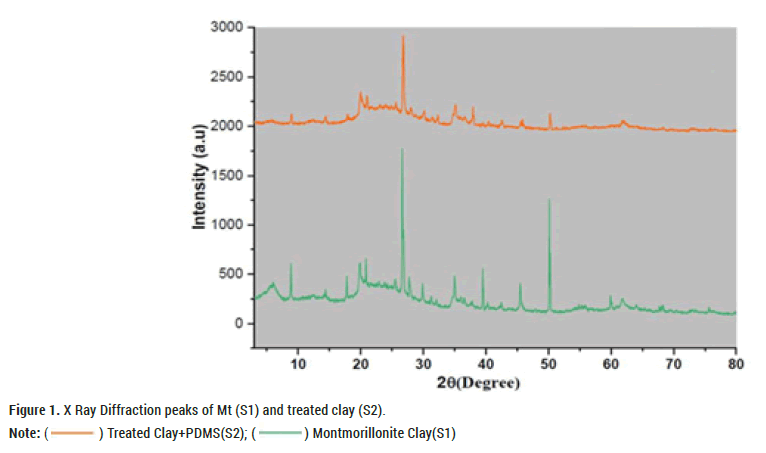
Figure 1. X Ray Diffraction peaks of Mt (S1) and tr eated clay (S2).
Note: (  ) Treated Clay+PDMS(S2); (
) Treated Clay+PDMS(S2); ( ) Montmorillonite Clay(S1)
) Montmorillonite Clay(S1)
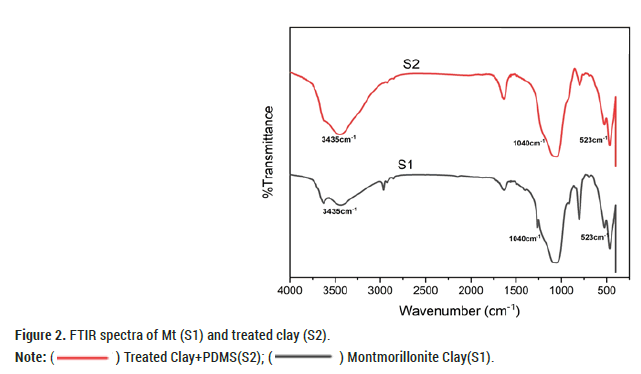
Figure 2. FTIR spectra of Mt (S1) and treated clay (S2).
Note: ( ) Treated Clay+PDMS(S2); (
) Treated Clay+PDMS(S2); ( ) Montmorillonite Clay(S1).
) Montmorillonite Clay(S1).
The specific surface areas of S1 and S2 from BET adsorption isotherm were 273 m2/g and 443 m2/g respectively. S2 also showed a broader pore size distribution than S1, as in Figure 3, necessary for better flux rate and decreased pressure during the filtration test. This result is congruent with the micrographs obtained in Figure 4. The porous structure of S2 was clearly indicated with pore size diameter being in the range of 116-163 nm. S2 is thus a macroporous material. Permeates from the membrane filtration test were collected and were calibrated against standard solutions fixing λmax for Ni2+ at 725 nm and for Co2+ at 514 nm. The calibrated Lambert Beer plot is shown in Figure 5 from which the concentration of the heavy metal ions can be calculated. As can be seen from Table 1, a higher pH facilitates the ease of removal of the heavy metal ion mainly through complexation. The formation of the green complex on the surface of the membrane is shown in Figure 6. The best result is shown for Ni2+ which shows a removal of 75% at pH11 for 800 ppm of the solution.
| Sample name | Nature of ion (40 mL) | pH | Ci (ppm) | Abs (from Calibration graph) | Cf (ppm) | % Removal (Ci- Cf/Ci) × 100 |
|---|---|---|---|---|---|---|
| S1 | Co2+ | 6 | 800 | 0.015 | 800 | No ion removal |
| S2 | Co2+ | 6 | 800 | 0.01 | 600 | 25 |
| S1 | Co2+ | 9 | 800 | 0.012 | 625 | 21 |
| S2 | Co2+ | 9 | 800 | 0.005 | 400 | 50 |
| S1 | Ni2+ | 8 | 800 | 0.015 | 800 | No ion removal |
| S2 | Ni2+ | 8 | 800 | 0.015 | 800 | No ion removal |
| S1 | Ni2+ | 11 | 800 | 0.0123 | 790 | 1.25 |
| S2 | Ni2+ | 11 | 800 | 0.0024 | 200 | 75 |
Table 1. Effect of pH on the removal of Co2+ and Ni2+ ions by Mt (S1) and treated clay (S2) membranes w.r.t the calibration graph above
| Sample name | Nature of ions (Co2++Ni2+) 20mL each | pH | Ci (ppm) | Abs | Cf (ppm) | % Removal (Ci- Cf/Ci) × 100 |
|---|---|---|---|---|---|---|
| S1 | Co2++Ni2+ | 6 | 600 | 0.01 | 600 | No removal |
| S2 | Do | 6 | 600 | 0.0042 | 350 | 41 |
| S2 | Do | 11 | 600 | 0.0055 | 450 | 25 |
Table 2. Showing competitive effect of removal of Ni2+ in presence of Co2+ ion
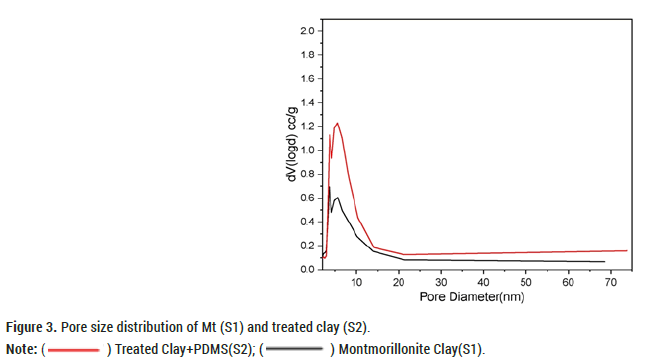
Figure 3. Pore size distribution of Mt (S1) and treated clay (S2).
Note: ( ) Treated Clay+PDMS(S2); (
) Treated Clay+PDMS(S2); ( ) Montmorillonite Clay(S1).
) Montmorillonite Clay(S1).
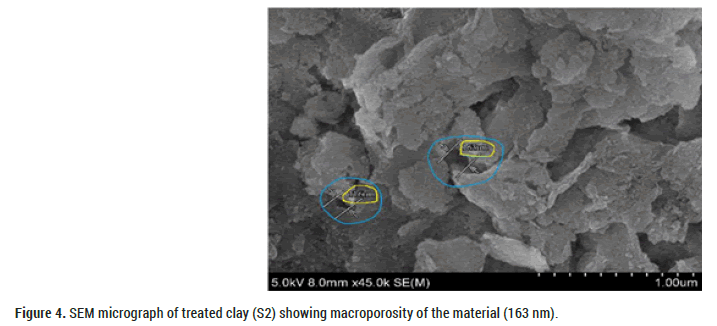
Figure 4. SEM micrograph of treated clay (S2) showing macroporosity of the material (163 nm).
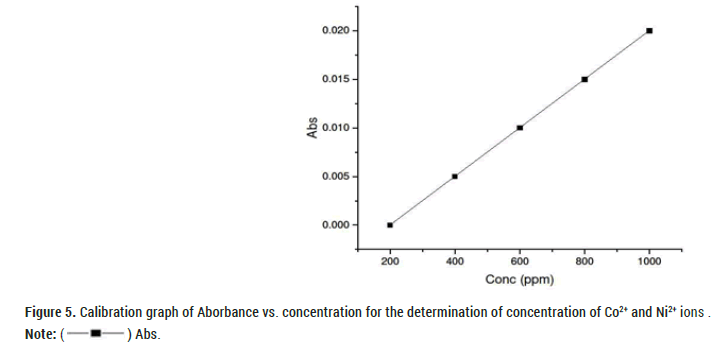
Figure 5. Calibration graph of Aborbance vs. concentration for the determination of concentration of Co2+ and Ni2+ ions .
Note: ( ) Abs.
) Abs.
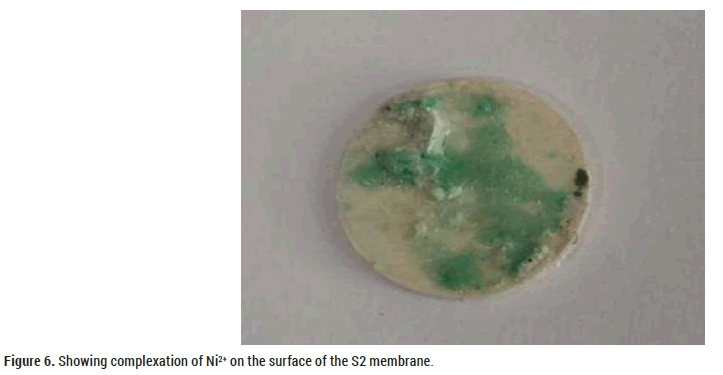
Figure 6. Showing complexation of Ni2+ on the surface of the S2 membrane.
When two ions Co2+ and Ni2+ ions are there in solution, it is seen from Table 2 that at higher pH it leads to decrease in the removal percentage. This may be due to the fact that both Co2+ and Ni2+ compete for complexation with -OH groups present on the surface of the treated clay, thus resulting in decrease in the removal of the ions [21].
The functionalization of clay surface aids in the development of tailor made materials with specific properties. The introduction of silanol groups promotes specific interactions with the heavy metals as a result of better surface area leading to enhanced adsorption and removal with better permeate flux rate. The efficiency of the membrane material is much governed by pH. As the pH is increased, it leads to higher surface charge thus favouring Ni2+ removal at a pH 11 due to surface complexation. In the presence of Co2+ and Ni2+, the removal efficiency decreases as the pH is increased as both the ions, being of the approximate ionic radii, compete for complexation with silanol groups on clay surface. Surface complexation involves the formation of direct bonds between heavy metals and surface OH groups on the clay surface. Much research is augured in this area of developing an ideal membrane material with good adsorption and desorption behavior, hydrophilicity, least fouling and better methods of regeneration of the heavy metals from the membranes.
The authors are thankful to Chemical Engineering Division, IIT Madras for analysis of samples by SEM. Authors are grateful to STIC, Cochin University of Science and Technology, CUSAT, Kochi for analysis of samples by XRD and FTIR, and BIT, Bangalore for providing BET data of samples.
The statements, opinions and data contained in all publications are solely those of the individual author(s) and contributor(s) and not of the editor(s). The editor(s) disclaim responsibility for any injury to people or property resulting from any ideas, methods, instructions or products referred to in the content.
[Crossref] [Google Scholar] [PubMed]
[Crossref] [Google Scholar] [PubMed]
[Crossref] [Google Scholar] [PubMed]
[Crossref] [Google Scholar] [PubMed]
[Crossref] [Google Scholar] [PubMed]
Citation: Cite this article: Choudhury, T., & Raol, H., et al. The Removal of Co (II) and Ni (II) from Model Wastewater by Functionalized Clay Hybrid Membrane. J Biol Todays World, 2023,12(4), 001-005
Received: 12-Jul-2023, Manuscript No. JBTW-23-105615; Editor assigned: 17-Jul-2023, Pre QC No. JBTW-23-105615 (PQ); Reviewed: 31-Jul-2023, QC No. JBTW-23-105615; Revised: 07-Aug-2023, Manuscript No. JBTW-23-105615 (R); Published: 14-Aug-2023, DOI: 10.35248/2322-3308-12.4.003
Copyright: Copyright: © 2023 Choudhury T, et al. This is an open-access article distributed under the terms of the Creative Commons Attribution License, which permits unrestricted use, distribution, and reproduction in any medium, provided the original author and source are credited.